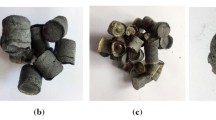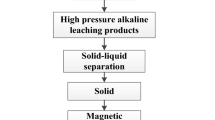Methods of chemical analysis, XRD, and pH monitoring are adopted in order to study wet extraction of Fe, V and Ti based on activated reduction, and the control conditions as well as the degree of recovery are determined. The primary-leaching in NaHCO3 saturated solution followed by final-leaching via carbonization is possible, and the leaching ratio for Na approaches 94% as the pH value of the alkali is controlled at 8 in the carbonization process. Metallic iron powder with an iron content of 94% is prepared by means of magnetic separation, and there are few slag fragments bearing V and Ti dispersed within iron particles. Precipitation of NaHCO3 and Si, Al impurities is completed during thorough carbonization at a pH value of 6, and the concentration of Si and Al in the resultant solution after carbonization meets the specifications for V extraction by an ammonia method. Residue from carbonization leaching displays good solubility in dilute acid, the leaching rate of Ti in dilute 15 vol.% hydrochloric acid exceeds 95%, and a purity of 98.4% for titanium white pigment is acquired from the acid-leaching lixivium by reheating hydrolysis. Finally, the overall degree of Fe, V and Ti recovery during wet extraction reaches 94, 90 and 90% respectively.







Similar content being viewed by others
References
Zhu Hong-min, Gao Cheng-jun, Huang Kai, and Cao Zhanmin, “Exploration of selective reduction of titanium-iron raw material and new metallurgical processes,” Nonferrous Metal of China, 2, 77–80 (2010).
Zhao Long-sheng, Wang Lina, Qi Tao, Chen Desheng, Zhao Hongxin, and Liu Yahui, “A novel method to extract iron, titanium, vanadium and chromium from high-chromium vanadium-bearing titanomagnetite concentrates,” Hydrometallurgy, 149, 106–109 (2014).
Chen De-sheng, Zhao Long-sheng, Liu Ya-hui, Qi Tao, Wang Jian-chong, and Wang Li-na, “A novel process for recovery of iron, titanium and vanadium from titanomagnetite concentrates: NaOH molten salt roasting and water leaching processes,” J. of Hazardous Materials, 244–245, 588–595 (2013).
J. Zhang, D. L. Yan, and Y. H. Qi, “Theoretical analysis on use of V–Ti magnetite in a new route,” Iron Steel Vanadium Titanium, 36, No. 3, 1–5 (2015).
J. Zhang, X. T. Dai, D. L. Yan, and Y. H. Qi, “Carbothermal sodium reduction process of vanadium-bearing titanomagnetite,” Iron and Steel, 51, No. 10, 6–9 (2016).
Q. Y. Chen, J. Zhang, Q. K. Cheng, D. L. Yan, and Y. H. Qi, “Study on carbothermal sodium reduction process of vanadium titanium magnetite concentrate,” Iron Steel Vanadium Titanium, 38, No. 2, 11–15 (2017).
Y. M. Zhang, L. Y. Yi, L. N. Wang, D. S. Chen, W. J. Wang, Y. H. Liu, H. X. Zhao, and T. Qi, “A Novel process for the recovery of iron, titanium and vanadium from vanadium-bearing titanomagnetite: sodium modification — direct reduction coupled process,” Intern. J. of Minerals, Metallurgy and Materials, 24, No. 5, 504–511 (2017).
Y. M. Zhang, L. N. Wang, D. S. Chen, W. J. Wang, Y. H. Liu, H. X. Zhao, and T. Qi, “A method for recovery of iron, titanium, and vanadium from vanadium-bearing titanomagnetite,” Intern. J. of Minerals, Metallurgy and Materials, 25, No. 2, 131–144 (2018).
X. Wu, D. S. Chen, L. N. Wang, H. M. Zhao, Y. L. Zhen, H. D. Yu, and T. Qi, “Study on one-step coal-based direct reduction and melting of vanadium titanium magnetite concentrate,” Nonferrous Metals (Extractive Metallurgy), 2, 15–20 (2019).
L. Y. Shi, Y. L. Zhen, D. S. Chen, L. N. Wang, and T. Qi, “Carbothermic reduction of vanadium-titanium magnetite in molten NaOH,” ISIJ Internat., 58, No. 4, 627–632 (2018).
B. X. Fu, X. H. Zhang, and Z. D. Chen, “Vanadium extraction and soda recovery from sodium vanadium slag with high silicon and phosphorus,” Iron Steel Vanadium Titanium, 2, 33–37 (1986).
Z. H. Zhang, W. L. Lu, Z. D. Cheng, X. H. Zhang, and W. B. Hu, “Extraction of vanadium from vanadium-slag containing soda and the recovery of soda,” Iron and Steel, 21, No. 10, 14–18 (1986).
S. Z. Wen and Y. Q. Zhang, “Preparation of high grade vanadium pentoxide from sodium vanadium-containing slag,” Iron Steel Vanadium Titanium, 1, 31–35 (1982).
Xue Tian-yan, Cleaner Production Process of Titanium Oxide by Decomposition of Titanium Slag with Molten Sodium Hydroxide, Dalian University of Technology (2009).
Author information
Authors and Affiliations
Corresponding author
Additional information
Translated from Metallurg, Vol. 65, No. 10, pp. 55–60, October, 2021. Russian DOI: 10.52351/00260827_2021_10_55.
Rights and permissions
About this article
Cite this article
Jun, Z., Feng, W., Yuan-hong, Q. et al. High-Efficiency Extraction of Fe, V, and Ti from Vanadium Titano-Magnetite Concentrate Based on Activated Reduction. Metallurgist 65, 1125–1132 (2022). https://doi.org/10.1007/s11015-022-01255-9
Received:
Published:
Issue Date:
DOI: https://doi.org/10.1007/s11015-022-01255-9




